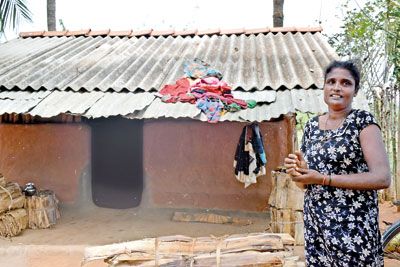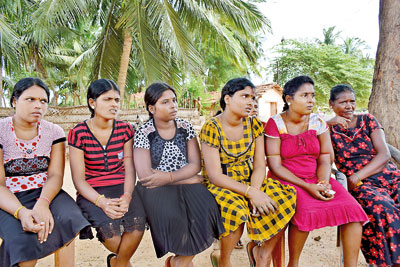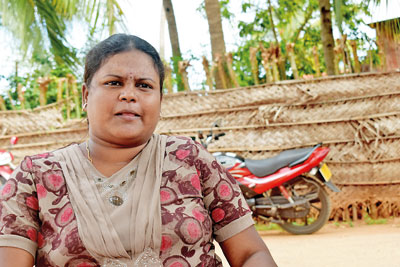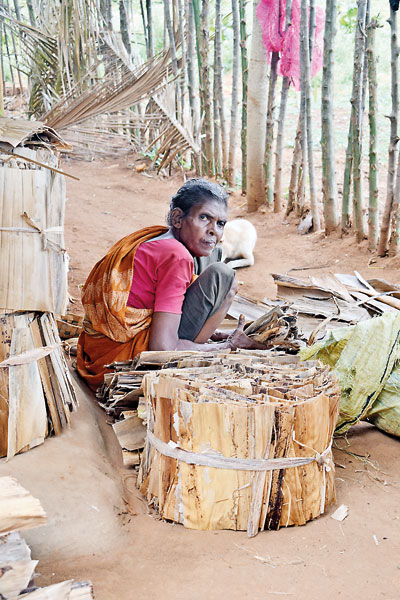News
Roofs over their heads: When will that day dawn for 15,639 landless people in Jaffna?
After squandering three years plugging unpopular prefabricated metal houses, the Government has approved two initiatives to build concrete and brick-and-mortar dwellings for war-affected people in the North and East.

Five people live in this roomless hut in Kalaimathy
But a key criterion to qualify for these homes is ownership of a plot of land. What happens then to the 15,639 people who are registered as landless in the Jaffna district alone?
Landlessness haunts people around the North and East. But it is most marked in the Jaffna district where the population is high and State-owned land is scarce. So those who do not hold title deeds live in shacks; semi-permanent houses cobbled together in a manner that echoes their occupants’ unsettled realities. Many of them stand on temple properties or abandoned private lands.
The Kalaimathy village in Puttur gained attention in recent months after its residents, all from the oppressed castes, demanded withdrawal of upper-caste cemeteries from amidst their settlements. This week, gathered under a tree, community leaders and others voiced frustration at not being able to purchase lands to accommodate their growing numbers.
Even those that do hold deeds cram their extended families into small houses because years of economic deprivation have left them unable to buy new properties at quoted prices. And enduring caste biases meant that those not of their own “classification” were reluctant to let them expand into other villages.
An old woman squatted inside one compound we visited in Kalaimathy, smoothing out and stacking sections of dried banana bark with her wizened hands. Her son-in-law was a wage labourer. They sold the bark as plates during temple festivals to supplement his meagre income.
Fifteen people, nine of them children, occupy this property. Five sleep in a low-roofed mud hut that had no rooms and where cooking is done on the floor. Everyone else fits into the other mud house that has two rooms and a kitchen. The rundown outhouse was unusable. But they did not have money to repair it.

What does the future hold for them: Some of the landless of Kalaimathy
The story is a familiar one here. Around 700 families live in Kalaimathy. Multiple families, trapped in a vicious cycle of wage labour—or ‘coolie’ work, as they call it—occupy single homes in cramped conditions. Odd jobs, including seasonal farm work and construction, earn them between 600-700 rupees a day. This goes towards food and other essentials.
There is only one university graduate in the village: a 27-year-old woman named Vahini Kathirgamarnathan, whose father once led campaigns on behalf of the oppressed castes. Poverty and other personal circumstances have stymied their efforts to proceed beyond basic education.
Living conditions among the landless are dismal. Hygiene is poor. These people are not seen as entitled to basic rights: toilets, wells, electricity. Many are from communities who have been historically marginalised.
Jaffna Muslims evicted by the LTTE in 1990 are also struggling to return and establish permanent housing in their old settlements near Jaffna town. But there is no land. So they pay exorbitant rents or return to the South where they have lived as displaced persons.
A development officer in Atchchuvely West—where the former Government’s efforts to revive a once vibrant industrial zone have fallen flat—said that housing topped a long list of needs among the inhabitants of five villages. She showed us photographs on her mobile phone of deplorable shacks.
“Most houses are small huts,” she said, asking not to be named. She was new to the area and was now gathering data on homelessness. “There are a large number of women-headed households. Others are very poor. The main income is from coolie work. Around 200 families are Samurdhi recipients.”
The Government’s points system for housing allocation left people out, she said. A household needed a minimum number of people to qualify. But others—like a destitute mother-and-daughter pair she knew who had nowhere to live—required roofs above their heads, too.

Vahini Kathirgamarnathan, the only graduate in Kalaimathy
“My estimate is that 30 to 50 families are landless,” the development officer said. “Every time, the Government gives about five houses to divisions in this area.”
If there was a man of working age, a family may not receive a dwelling. Yet, more often than not, he wouldn’t have a regular job or the avenues to secure one.
At the height of a Monday afternoon, some able-bodied men lolled outside the Vairavar Kovil in Thoppuram Weerawatta, Chankanai. Just one of them, Murukadas Thilakshan from Victoria College Chulipuram, was sitting his A/Levels this year. He played volleyball and cricket at national level so had qualified for a scholarship.
But several others said they did coolie work when it was available. They hadn’t had enough money to pursue higher studies. Why did they not find jobs? “Even those who have gone to campus are without jobs,” scoffed Thilakshan’s friend. “Who will take us?”
They said that employment agents solicited hundreds of thousands of rupees in exchange for, say, bank jobs. But there was no question of coming into that kind of money.
This is a tragedy replicated everywhere. Despite being eligible, miserably poor families risk being excluded because they did not meet every criterion. And land title was an imperative they just could not get around.
In the North and East, many people were rendered homeless because of the war. And their livelihoods were decimated. That is how these regions differ so starkly from the rest of the country. These special needs have to be met and have to be recognized as unique.
After the war, housing schemes, including one supported by the Indian Government, were implemented. By 2015, more than 100,000 houses were built. Grants were provided to those who owned lands. Others were given “permit lands” by the State. Many more landless households, however, fell through the slats.

There is dire poverty in Kalaimathy
By the Government’s own admission (contained in Cabinet memoranda submitted by the Ministry of Rehabilitation and Resettlement), there was a need to build 170,000 houses by the end of 2017. That included 60,000 houses for refuge returnees who “have lost all their properties during the 3 decades of conflict”, according to a Cabinet paper dated April 25, 2018.
The Government has now given the go-ahead for a consortium of humanitarian organizations to build 25,000 brick-and-mortar type houses. It has also sanctioned the construction of 40,000 prefabricated concrete houses by a Chinese company that has introduced such dwellings in the hill-country. There is no mention of the landless.
“There are more than 14,000 landless people,” said Jaffna Government Agent N Vethanayagam. “Some are on temple land, others on private land. The problem is that we cannot give housing or assistance to the most vulnerable people. We have no State land in these areas.”
This was discussed at a recent Jaffna District Coordinating Committee meeting. The only viable option was for the State to purchase private properties on behalf of the landless. The idea of condominiums was also floated; as was the remote possibility of relocating families to other districts.
“There is no solution at the moment,” Mr Vethanayagam said, adding that it was not possible to buy lands for everyone that needed them. However, the Government will do so on behalf of some 400 families who still lived in welfare centres. Already, 154 have been allocated land.
That still left thousands out of the loop, including many hapless residents of Kalaimathy.
They were less oppressed than in the past, reflected W. Manoharan, 57. There were improvements now in terms of access to education and access to Hindu temples. But to emerge from the economic mire they were trapped in, they need a hand–and recognition of their basic rights by those they help elect to power.

